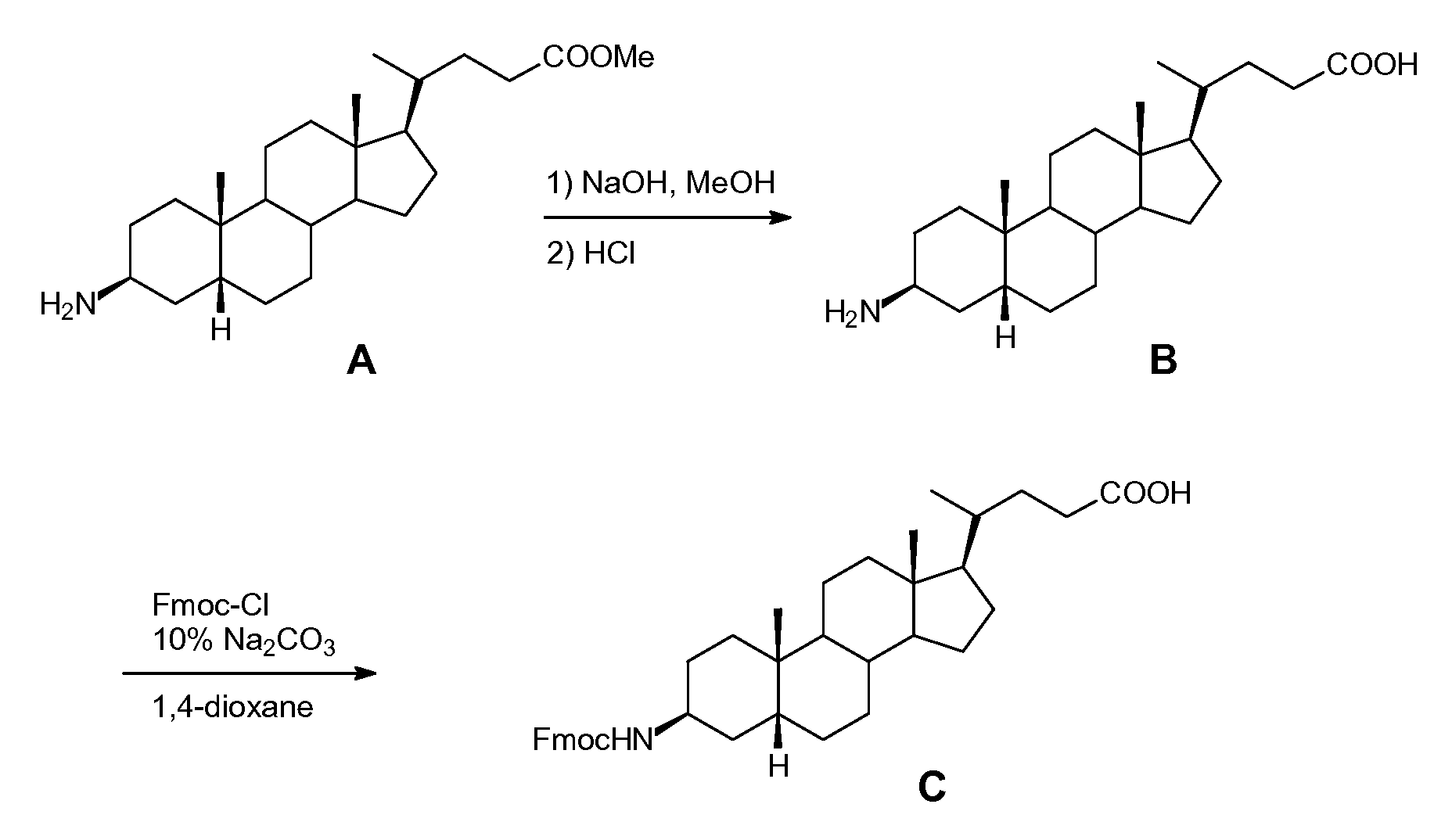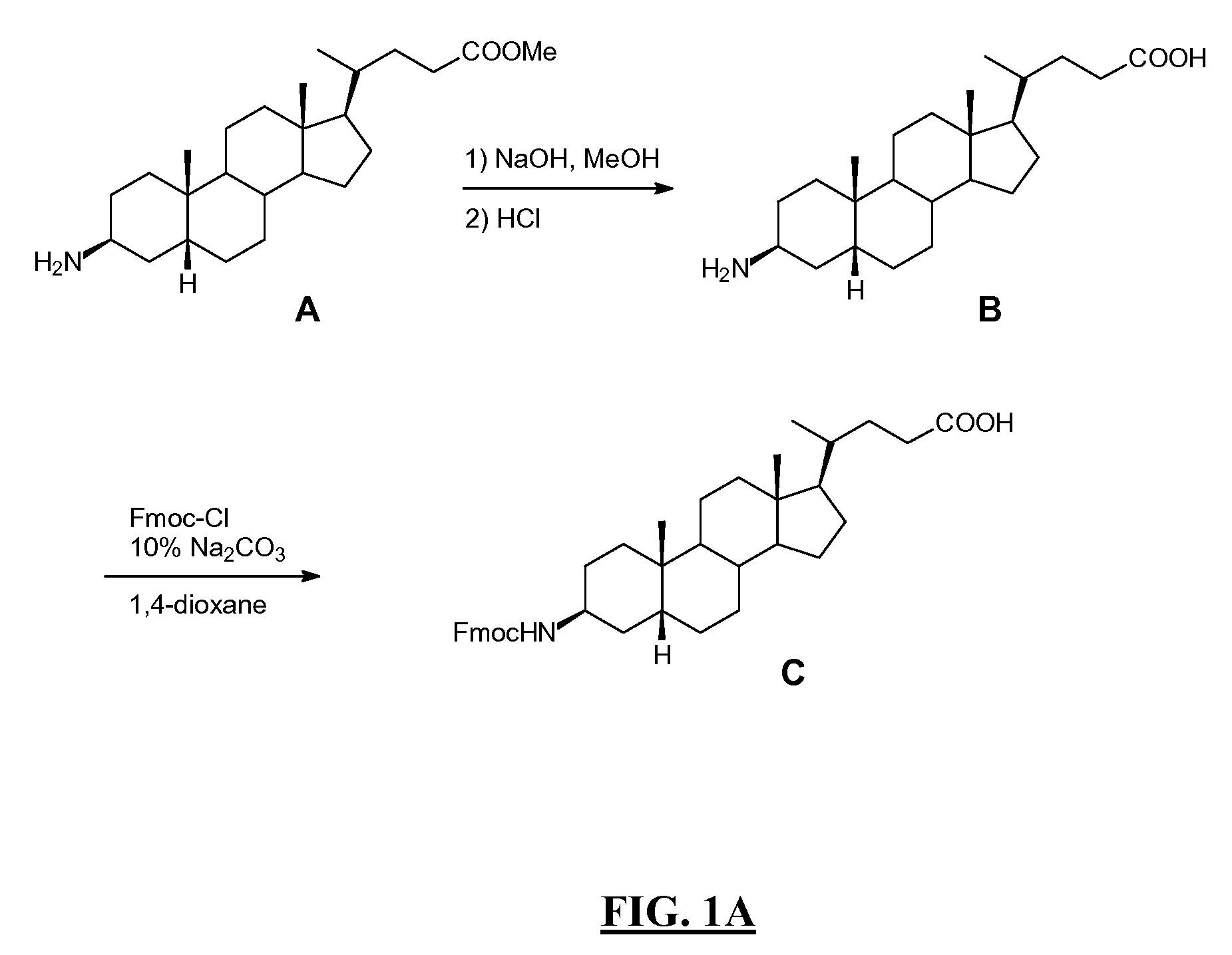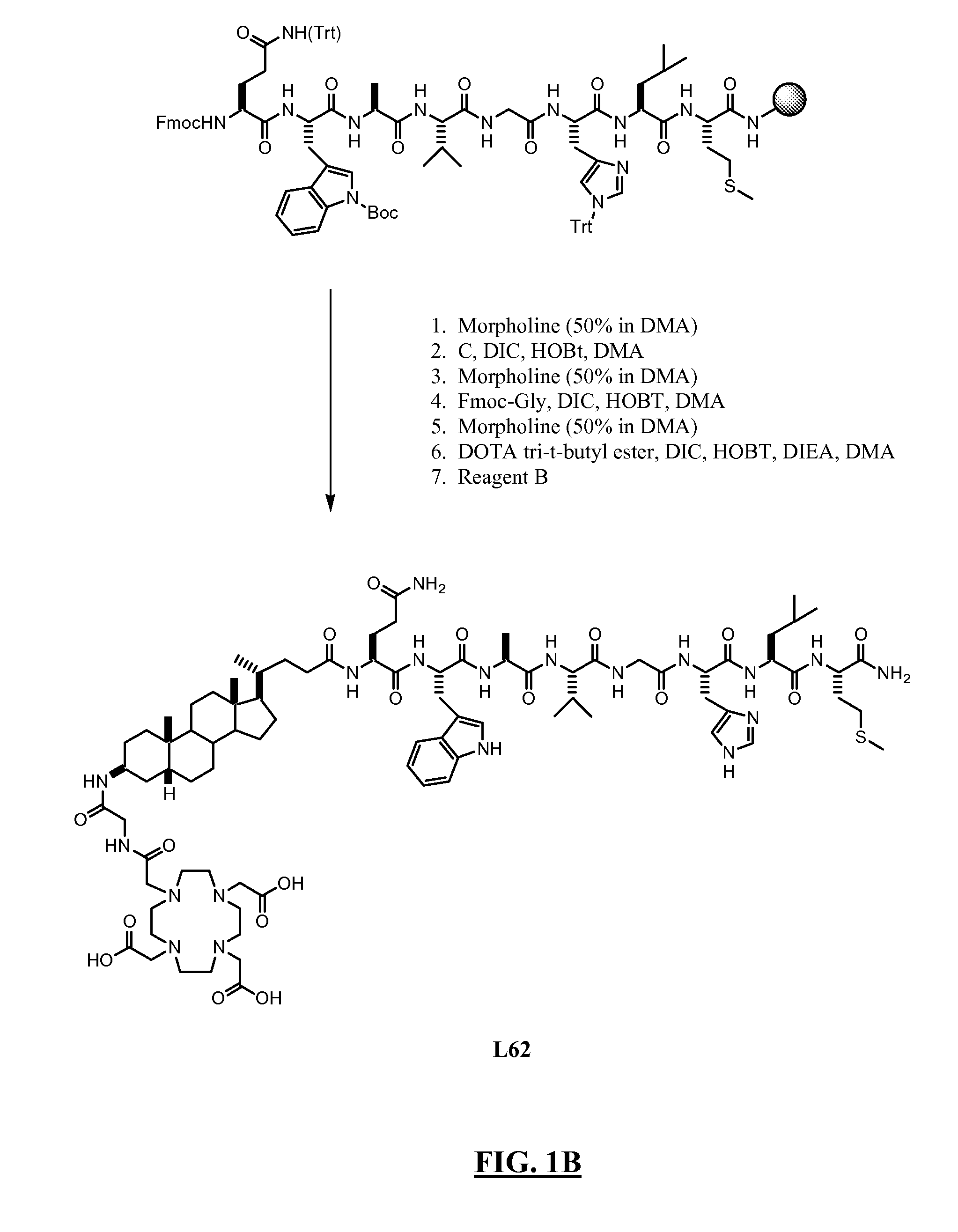Gastrin Releasing Peptide Compounds
a peptide and gastrin technology, applied in the field of new drugs, can solve the problems of affecting the development of hormone sensitive prostate cancer, and rarely cure cancer by drugs, so as to accelerate the targeting of grp-expressing target tissue, delay the progression of prostate tumors, and improve the effect of gastrin releasing peptides
- Summary
- Abstract
- Description
- Claims
- Application Information
AI Technical Summary
Benefits of technology
Problems solved by technology
Method used
Image
Examples
example 1
FIGS. 1A-B
Synthesis of L62
[0364]Summary: As shown in FIGS. 1A-B, L62 was prepared using the following steps: Hydrolysis of (3β,5β)-3-aminocholan-24-oic acid methyl ester A with NaOH gave the corresponding acid B, which was then reacted with Fmoc-Cl to give intermediate C. Rink amide resin functionalised with the octapeptide Gln-Trp-Ala-Val-Gly-His-Leu-Met-NH2 (BBN[7-14] (SEQ ID NO: 1) was sequentially reacted with C, Fmoc-glycine and DOTA tri-t-butyl ester. After cleavage and deprotection with Reagent B the crude was purified by preparative HPLC to give L62. Overall yield: 2.5%. More details are provided below:
A. Rink Amide Resin Functionalised with Bombesin[7-14] (SEQ ID NO: 1) (A)
[0365]In a solid phase peptide synthesis vessel (see enclosure No. 1) Fmoc-amino acid (24 mmol), N-hydroxybenzotriazole (HOBt) (3.67 g; 24 mmol), and N,N′-diisopropylcarbodiimide (DIC) (3.75 mL; 24 mmol) were added sequentially to a suspension of Rink amide NovaGel™ resin (10 g; 6.0 mmol) A in DMF (45 mL)...
example ii
FIGS. 2A-F
Synthesis of L70, L73, L74, L115 and L116
[0371]Summary: The products were obtained by coupling of the octapeptide Gln-Trp-Ala-Val-Gly-His-Leu-Met-NH2 (BBN(7-14) (SEQ ID NO: 1) (with appropriate side chain protection) on the Rink amide resin with different linkers, followed by functionalization with DOTA tri-t-butyl ester. After cleavage and deprotection with Reagent B the final products were purified by preparative HPLC. Overall yields 3-9%.
A. Synthesis of L70 (FIG. 2A):
[0372]Resin A (0.5 g; 0.3 mmol) was shaken in a solid phase peptide synthesis vessel with 50% morpholine in DMA (7 mL) for 10 min, the solution was emptied and fresh 50% morpholine in DMA (7 mL) was added. The suspension was stirred for 20 min then the solution was emptied and the resin washed with DMA (5×7 mL). Fmoc-4-aminobenzoic acid (0.43 g; 1.2 mmol), HOBt (0.18 g; 1.2 mmol), DIC (0.19 mL; 1.2 mmol) and DMA (7 mL) were added to the resin, the mixture shaken for 3 h at room temperature, the solution was...
example iii
FIGS. 3A-E
Synthesis of L67
[0375]Summary: Hydrolysis of (3β,5β)-3-amino-12-oxocholan-24-oic acid methyl ester A with NaOH gave the corresponding acid B, which was then reacted with Fmoc-Glycine to give intermediate C. Rink amide resin functionalised with the octapeptide Gln-Trp-Ala-Val-Gly-His-Leu-Met-NH2 (BBN[7-14] (SEQ ID NO: 1) was sequentially reacted with C, and DOTA tri-t-butyl ester. After cleavage and deprotection with Reagent B the crude was purified by preparative HPLC to give L67. Overall yield: 5.2%.
A. Synthesis (3β,5β)-3-Amino-12-oxocholan-24-oic Acid, (B) (FIG. 3A)
[0376]A 1 M solution of NaOH (6.6 mL; 6.6 mmol) was added dropwise to a solution of (3β,5β)-3-amino-12-oxocholan-24-oic acid methyl ester A (2.1 g; 5.1 mmol) in MeOH (15 mL) at 45° C. After 3 h stirring at 45° C., the mixture was concentrated to 25 mL then H2O (25 mL) and 1 M HCl (8 mL) were added. The precipitated solid was filtered, washed with H2O (2×30 mL) and vacuum dried to give B as a white solid (1.7 g...
PUM
| Property | Measurement | Unit |
|---|---|---|
| radioactive | aaaaa | aaaaa |
| time | aaaaa | aaaaa |
| vascular permeability | aaaaa | aaaaa |
Abstract
Description
Claims
Application Information
 Login to View More
Login to View More - R&D
- Intellectual Property
- Life Sciences
- Materials
- Tech Scout
- Unparalleled Data Quality
- Higher Quality Content
- 60% Fewer Hallucinations
Browse by: Latest US Patents, China's latest patents, Technical Efficacy Thesaurus, Application Domain, Technology Topic, Popular Technical Reports.
© 2025 PatSnap. All rights reserved.Legal|Privacy policy|Modern Slavery Act Transparency Statement|Sitemap|About US| Contact US: help@patsnap.com



